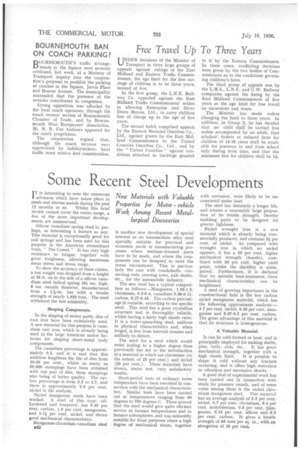Some Recent Steel Developments
Page 52

If you've noticed an error in this article please click here to report it so we can fix it.
New Materials with Valuable Properties for Motor vehicle Work Among Recent Metallurgical Discoveries
IT is interesting to note the numerous advances which have taken place in steels and ferrous metals during the past 12 months or so. Whilst this brief review cannot cover the entire range, a few of the more important developments are summarized.
Silicon vanadium spring steel is, perhaps, as interesting a feature as any. This material is exceptionally good for coil springs*and has been used for this purpose in the American streamlined train, " The Comet." It has very high resistance to fatigue, together with great toughness, allowing maximum mean stress and stress range.
To show the accuracy of these claims, a ton weight was dropped from a height of 35 ft. on to the side of a silicon vanadium steel helical spring 101 ins. high, 8 ins. outside diameter, manufactured from a 1-136-in. bar with a tensile strength of nearly 1,920 tons. The steel withstood the test admirably.
Shaping Components.
In the shaping of motor parts, dies of cast iron have been extensively used. A new material for this purpose is vanadium cast iron, which is already being used in the large American motor factories for shaping sheet-metal body components.
The vanadium percentage is approximately 0.2, and it is said that this addition lengthens the life of dies from 10-30 per cent., whilst as many as 50,000 stampings have been obtained with one pair of dies, the stampings also being of better quality. The carbon percentage is from 3.5 to 3.7, and there is approximately 0.5 per cent. nickel in the analysis.
Nickel manganese steels have been studied. A steel of this type, oilhardened and tempered, has 0.35 per cent. carbon, 1.0 per cent, manganese, and 1-1f per cent, nickel, and shows good mechanical characteristics.
Manganese-chromium-vanadium steel B42
is another new development of special interest as an intermediate alloy steel specially suitable for practical and economic needs in manufacturing processes where medium-stressed parts have to be made, and where the components can be designed to meet the stress encountered. This is particularly the case with crankshafts, connecting rods, steering arms, axle shafts, etc., for the automobile industry.
The new steel has a typical composition as follows:—Manganese, 1.05-1.3; chromium, 0.3-0.4; vanadium 0.08-0.11; carbon, 0.27-0.45. The carbon percentage is variable, according to the specific need. This steel has a good crystalline structure and is thoroughly reliable, whilst having a fairly high elastic ratio. It is a water-quenching steel, uniform in physical characteristics and, when forged, is free from internal stresses and unlikely to distort.
The need for a steel which would resist scaling to a higher degree than previously has led to the introduction of a material in which are chromium (to the extent of 25 per cent.) and nickel (20 per cent.). These materials have shown, under test, very satisfactory results.
Short-period tests at ordinary room temperature have been executed in connection with the mechanical characteristics. Similar tests have been carried out at temperatures ranging from 60 degrees to 700 degrees C. These proved that the steel would give quite efficient service at furnace temperatures and in furnace atmospheres, and was eminently suitable for those purposes where a high degree of mechanical stress, together
with corrosion, were likely to be encountered under heat.
The steel has definitely a longer life, and retains a reasonably large proportion of its tensile strength, thereby enabling parts to be designed for greater lightness.
Nickel wrought iron is a new material which is already being commercially produced, and contains 3f per cent, of nickel. As compared with wrought iron in which no nickel appears, it has a 25 per cent. higher mechanical strength (tensile), combined with 50 per cent, higher yield point, whilst the ductility is unimpaired. Furthermore, it is declared that by suitable heat-treatment, these mechanical characteristics can be heightened.
A steel of growing importance in the constructional field is the low carbon nickel manganese material, which has the following approximate analysis:4-7 per cent. nickel, 0.35 per cent, manganese and 0.07-0.2 per cent, carbon. The great advantage of this material is that its structure is homogeneous.
A Valuable Material.
It can be cold-formed or bent, and is principally employed for making shafts, pins, bolts, rods, etc. It has great mechanical strength, together with a high elastic limit. It is possible to shape it cold without any fracture occurring, and it offers high resistance to vibration and successive shocks.
A good deal of experimental work has been carried out in connection with steels for pressure vessels, and of some value among these is the nickel chromium manganese steel: This material has an average analysis of 2.5 per cent. nickel, 0.7 per cent. chromium, 0.4 per cent. molybdenum, 0.5 per cent. manganese, 0.15 per cent. silicon and ,0.3 per cent. carbon. It gives a tensile strength of 65 tons per sq. in., with an elongation of 20 per cent.
















































































